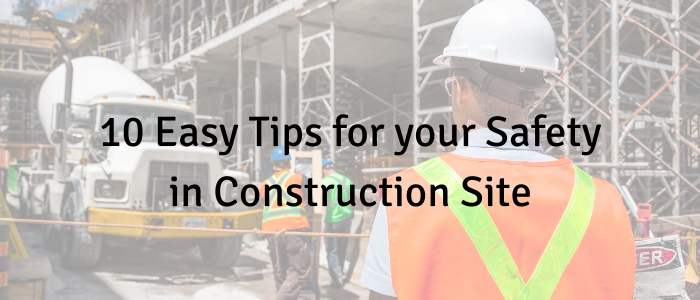Safety in Construction Site
Truly, one of the dangerous and risky location of work at are construction sites. It is easy to injury yourself if you did not pay attention for a second for what is going on around you. Each year, thousands of workers around the globe get injured while working on construction sites.
If your profession is related to construction, this article provides you with 8 very simple rules that you keep in mind while you are in a construction site to make sure that yourself, and others, are safe.
1. Wear your Personal Protective Equipment (PPE) at all times
Before going into the site, confirm that you have all the necessary PPE that you may need. PPE represents your last line of defense against hazards.
PPE includes:
- Hi-Viz: make sure you are seen
- Safety Goggles: protects your eye from foreign objects
- Safety boots: give you grip and protect your feet
- Hard hats
- Any additional PPE required for the task in place.
2. Keep site organized
Construction work is usually messy. Slips and trips will not seem to be a serious problem in comparison to other high-risk work happening on the site, but don’t be fooled. Statistics say that in a year, slips and trips accounts for 30% of specified major injuries on construction sites. So, remember to keep your work area tidy. Pay special attention to access and escape routes.
3. Follow safety signs/procedures
Make sure you understand the meaning of safety signs and act accordingly by following these signs appropriately.
4. Never work in unsafe locations
You have the right to refuse unsafe work. Always make sure your work site is safe. Be aware of what is going on around you. 14% of fatalities in construction were caused by something collapsing or overturning, and 11% by being struck by a moving vehicle.
Don’t:
- Work at heights without suitable guard rails
- Don’t enter unsupported trenches
- Work below crane loads.
5. Report defects
If you come across an issue, do not pretend you did not see it. Instead, practice your due-diligence part and report it immediately to your supervisor. Effective Action can mainly be taken quickly if the management has been made aware of the problem. The earlier problems are resolved, the less chance for an accident to happen.
6. Never tamper with equipment
If a device is not working, or doesn’t look right, don’t try and force it to work.
Don’t:
- remove guard rails or scaffold ties.
- remove machine guards.
- attempt to fix defective equipment unless you really can.
- ever tamper with equipment without authorization.
7. Use the right equipment for the job
Naturally, a single tool can’t be used for all kind of jobs. Using the right tool for the job will gets it done quicker, and most importantly, safer. Visually check equipment is in good condition and safe to use before you start.
8. Ask, if in doubt
Does not know what safe procedure you should follow? it is better if you ask you manager or supervisor on how to do it right. It’s better to be safe than sorry. Mistakes on construction sites can cost lives, don’t let it be yours.
Read Also
